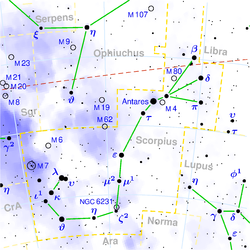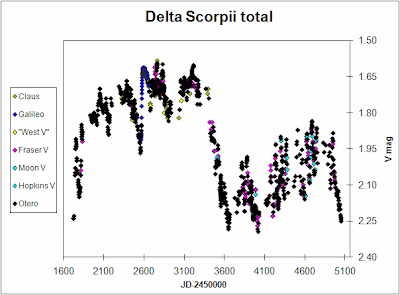 Based on recent visual observations, my friend Sebastian Otero brought up some interesting facts about stars in the constellation of Scorpius. It seems the brightest star in the constellation, Antares (alpha Scorpii) is fainter than usual. Antares is a variable star, whose apparent magnitude varies from +0.88 to +1.16.
Based on recent visual observations, my friend Sebastian Otero brought up some interesting facts about stars in the constellation of Scorpius. It seems the brightest star in the constellation, Antares (alpha Scorpii) is fainter than usual. Antares is a variable star, whose apparent magnitude varies from +0.88 to +1.16.According to Sebastian, " I have never seen Antares so faint. It is fading to a very faint minimum in its short-term pulsation cycle but it is in the middle of a minimum of its long-term periodicity. This combination results in this very faint state. It is almost as faint as beta Crucis tonight (I made it V= 1.23). You can see light curves in my webpage."
Sebastian, a native of Argentina, is one of the world's leading variable star observers. He has what many consider to be near photometric capabilities. His binocular and naked eye magnitude estimates rival the precision of observers using CCDs and photoelectric photometers.
 In June 2000, Sebastian discovered the variability of delta Scorpii, a previously unknown variable star. Delta Scorpius' brightness has varied since then and has reached as high as magnitude 1.6, altering the familiar appearance of the constellation Scorpius.
In June 2000, Sebastian discovered the variability of delta Scorpii, a previously unknown variable star. Delta Scorpius' brightness has varied since then and has reached as high as magnitude 1.6, altering the familiar appearance of the constellation Scorpius."Delta Sco also happens to be in a faint state, almost reaching quiescence. The 60-day periodicity that was dominant over the past years seems to be disappearing. Is the star going to stop varying for now?" asks Argentina's famous variable star observer. With irregular, unpredictable variable stars like delta Scorpii, no one knows for sure what comes next. That's half the fun of observing variable stars.
Taking all this into account, its easy to see that the appearance of the constellation Scorpio will be dramatically altered from its normal state. As Sebastian explains, "This means that the scorpion looks very much dimmer as a whole!"
If you get a chance tonight or tomorrow, go take a look for yourself. You may never see the Scorpion like this again.


No comments:
Post a Comment